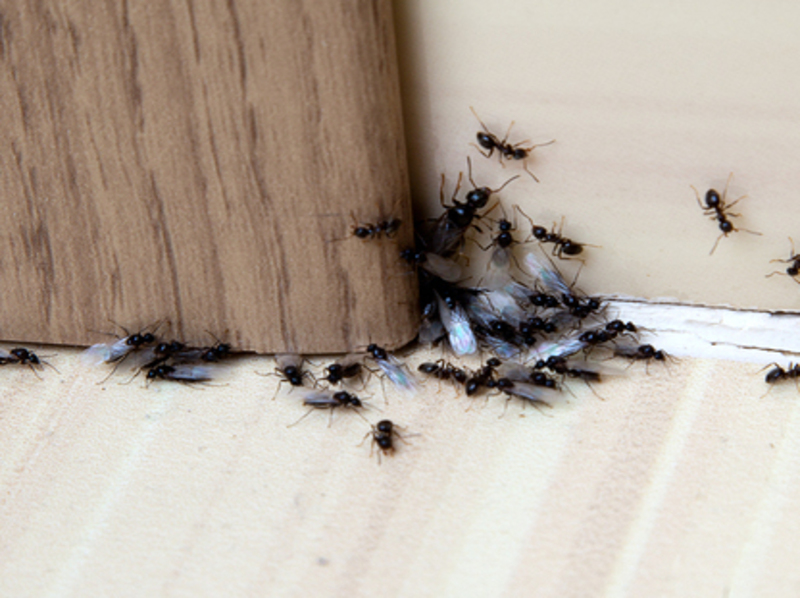Agrohomeopathy for Creepy Crawlies
|
Kaviraj is our resident expert in using homeopathy for plant, soil, and pest problems. From Hippy to Homeopath: the Story of Vaikunthanath das Kaviraj. |
Contents
- Beetles and cyclids
- Silverfish
- Ant infestation
- Earwigs
- Hydrophobic soil under gum trees
- Spiders
- Processional caterpillars
- Camelia plant dying afer transplant
- Instructions for storage and use of remedies
- Ask Kaviraj your questions
- Looking for More Information?
Questions and Answers
Q1: Beetles and cyclids. Have you got anything for beetles and cylids? I’m making a spray at present from two beetles caught in my birdbath overnight! Eeew! But they are so destructive to my lawn and some trees. (Question from Helix tosta survey responses)
There are a few remedies for – or rather against – beetle infestations. Many beetles are predators though and can be beneficial in the garden so you have to make sure you are getting rid of the right (wrong) beetles. Cantharis (Spanish Fly) is one of the useful remedies for removing beetles.
Q2: Silverfish. Is there a remedy for silverfish? I’ve seen 2 at home in the past 2 days and normally I don’t see any. I would love a non-toxic remedy with no odour that is different to moth balls so that I don’t have worry about the kids handling it, or worse, eating it. (A.P.)
Hi A.P. I haven’t yet tried any remedies against silverfish yet but one possibility is Coccinella , a remedy prepared from the ladybird beetle. I have found it to be a good remedy for soft-bodied insects. Because the silverfish is a soft primitive insect that always stays in the larval stage and has no instars (moulting phases), Coccinella could easily get rid of it. Mind you, I have never tried this, so I cannot guarantee success.
Q3: Ant infestation. I have just read your Arsenicum for Cockroaches article. Do you think it would work against an ant infestation as well? Is there something else that would work better? Ricki Bernstein.
Hi Ricki. Ants are very different creatures to the cockroach. First, they live in colonies and second, it depends on the type of ant. The little black ones hate Calendula and Tagetes so you could use these remedies against them. You may be able to repel other ants with Formica rufa, which is the remedy made from the ant. It may produce good results or may not, depending on your ant. It works for several types of insects so there is probably a 50/50 chance of it doing something for your ant problem. I don’t know yet what to do with the fire-ant, although a potency of themselves could also do wonders, who knows? Give them a try and let us know.
Q4: Earwigs. How about a homeopathic treatment to get rid of earwigs in the veg garden? Earwigs are a MAJOR problem here in SA and they get more of our vegetables than we do – darn things! (Lyn)
Hi Lyn. This is another insect that I have not yet had to deal with in my agrohomeopathy work. The best thing would be to find out what its natural predator is and use that in potentised form. Coccinella, the potentised ladybird beetle may possibly work and could be tried.
Q5: Hydrophobic soil under gum trees. The soil under my gum tree was hydrophobic and the grass non-existent (I think due to the waxy coating on gum leaves, nuts and drawing roots). Using the exoskeleton dissolving principle of Helix tosta, I sprayed it on the soil to test. (what have I got to lose, I thought – it might dissolve the waxy stuff.) The results are not noticeable yet. (Question from Helix tosta survey responses)
Hello. Eucalypts have similar properties to Juglans nigra – the black walnut. They inhibit the growth of seeds of other plants. If you make a remedy out of Eucalypt leaves you may also be able to could get rid of the weeds in your garden.
Q6: Spiders. Thanks so much for this article about Arsenicum and cockroaches. We have a spider infestation and don’t want to spray chemicals in the house. Is there a homeopathic deterrent for spiders? Gayatri Rampal.
Dear Gayatri. Spiders are predators that keep a lot of unwanted insects out of the house. If you get rid of the spiders you will have many more pests. So I would choose the lesser of two evils – if you would call it that way, and leave the spiders in place, keeping the insects out.
Q7: Processional Caterpillars. I live in the south of France, in the hinterland behind Cannes. There are many pine trees which harbour the processional caterpillar. These caterpillars are toxic and I find it very difficult to keep my dachshunds away from them. PLEASE, is there a remedy which will deter these catarpillars AND is there a remedy to help my dogs if they sniff one? Thank you for your help. (V.M.)
Dear V.M. You can use Bombyx processiona, which is made from the caterpillar itself, and spray the places where they are. As you probably already know, the poison coming off the hairs on the caterpillar has killed children in the past so your dogs may also not survive if they come in contact with them. Always take a bottle of the remedy with you on your walks so that if a dog does inadvertently get the poison, you can immediately antidote with the remedy. One pill or 5 drops from the bottle every every 5 minutes is a necessity for the first hour. After that reduce the frequency to every 10 minutes for 1 hour. Then every 20 mins. By that time, your dog should be ok. Alternatively, you can use Sambucus Nigra for spraying where the caterpillars are if Bombyx doesn’t do the trick.
Q8: Camelia plant dying afer transplant. Hi Kaviraj. After having such success with my rhubarb plant using Helix tosta, I had a sudden thought that you may be able to help save my poor camelia plant from dying. A few months ago my husband Chris transplanted our camelia plant to our side garden. He dug out the whole plant which had a very shallow root system. He gave it quite a large prune (he trimmed it all over by about a third). It was moved from a place of rich soil to an area of clay soil. He put some potting mixture in the hole and then planted it. All the leaves turned brown and then fell off. It still looks very distressed but we can see a few green buds appearing and two small patches of green leaves on one of the main trunk/branch. It is a long way off being the full flourishing plant it once was.
I sprayed the camelia plant the other day with silicea 6C after reading how it can help plants but then thought there may be a more appropriate remedy. Does something else spring to mind? I’ve attached some photos of the bush for you so you can see how badly it has been affected – you are getting three of them because my children didn’t want to miss out on the action. Thanks for your help, Michelle Keats.
Hi Michelle. It sounds like a case of Carbo vegetabilis (Carb-veg.) to me. Let me tell you something about Carbo veg. and transplants that go wrong. First of all, your camellia has been planted into a completely different soil – it will have a different pH and thus different nutrient availability. So, first of all, you need to consider changing the soil consistency. If it is clay, for instance, it will be difficult for the roots to penetrate it. Put a thick layer of old cow dung on the top of the soil above the plant. Ad a handful of worms for good measure and they will work it into the clay and allow the growth of hair-roots. These are necessary for uptake of water and nutrients.
The loss of hair roots from the transplantation is the cause of your camellia’s condition – without hair-roots there is a loss of vital fluids, which is a keynote symptom for Carbo veg. I have rescued many trees with Carbo veg, even when they already seemed dead. In Western Australia I replanted grass trees when they had been bulldozed to make way for housing estates and Carbo veg. increased their chances of survival from 10% to 90%. Give your camellia a dose of Carbo veg in a 6X or 6C potency – whichever is available to you. To this end put 10 pills in a 1/2 litre of water. Once dissolved you succuss (forceful rhythmic bouncing the bottle off a more or less flexible surface, like a book) ten times to obtain an even mixture. With this 1/2 litre make up a watering can – use the equivalent of 1 part to 19 parts, depending on the size of your Camelia – you know how much water she takes – and water it into the ground above the roots. Do not repeat too soon, because the Carbo-veg will have an effect for a long period of time. As long as your camellia is making progress, don’t repeat. Please keep us posted about the progress or lack thereof, if that would be the case.
Instructions for Agrohomeopathy Remedy Use and Storage
Just add one 6X or 6C potency pill to each 200 ml of water, shake vigorously, and then spray on the leaves of your plant or water into its roots. If using the remedy for household pests, spray where the pests normally gather or run.
Store pills and liquid away from light, moisture, and high temperatures (normal household temperatures are fine). Close range mobile phone and microwave oven emissions have been shown to affect homeopathic remedies. Keep your pills and liquid away from these appliances.
1 x vial of 100 pills from the Homeopathy Plus Shop makes 20 litres of remedy.
Note about KavirajVaikunthanath Kaviraj passed away in March 2013 but left an enormous legacy of how to safely manage plant pests and diseases with homeopathy. |





